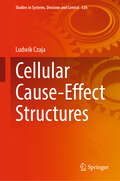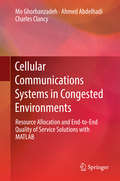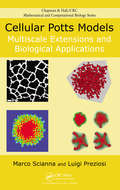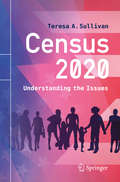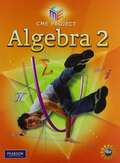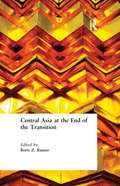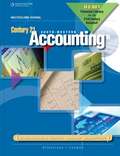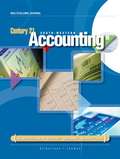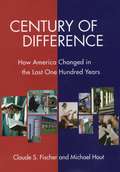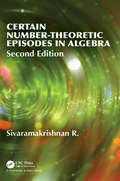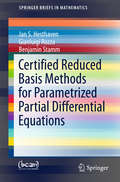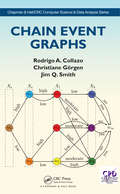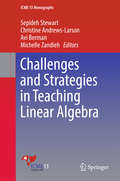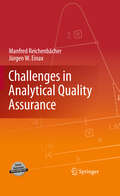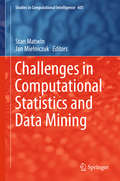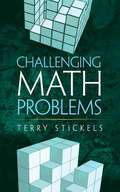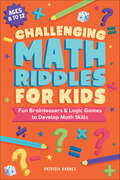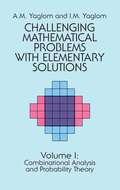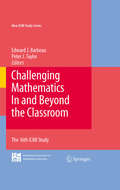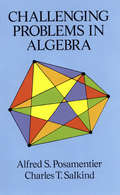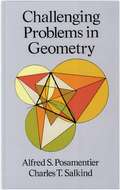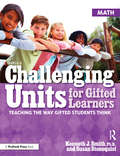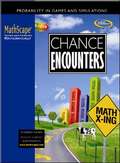- Table View
- List View
Cellular Cause-Effect Structures (Studies in Systems, Decision and Control #526)
by Ludwik CzajaThis book presents the adaptation of cause-effect structures to the formal description of phenomena such as the behaviour of living objects, the mutual communication of living cells, but also such as the growth of crystals and other natural processes. The system of cause-effect structures has been designed for the description and analysis of objects with dispersed components, acting concurrently and synchronizing and communicating one another. This adaptation consists in customizing generic semantics of cause-effect structures to semantics specific to the behaviour of natural objects. That is creating evolution rules for the formal models of these objects. However, the structural, algebraic properties of cause-effect structures are retained. The activity of cellular cause-effect structures is supposed to imitate the activity of cellular automata, the formal system intended for the above-mentioned aims. But operations on syntactic constructions, in particular their transformations and simplification, are the same as for the general cause-effect structures. These algebraic operations are also used to perform certain geometric/topological conversions of location bases for the cellular cause-effect structures, like flat surfaces into cylindrical or toroidal. This is depicted by numerous illustrations. An adaptation of cause-effect structures to other formal descriptions of some natural phenomena, such as reaction systems, is provided in book 331 of the “Lecture Notes in Networks and Systems” series, whereas the complete description of cause-effect structures, in book 45.
Cellular Communications Systems in Congested Environments: Resource Allocation and End-to-End Quality of Service Solutions with MATLAB
by Ahmed Abdelhadi Mo Ghorbanzadeh Charles ClancyThis book presents a mathematical treatment of the radio resource allocation of modern cellular communications systems in contested environments. It focuses on fulfilling the quality of service requirements of the living applications on the user devices, which leverage the cellular system, and with attention to elevating the users' quality of experience. The authors also address the congestion of the spectrum by allowing sharing with the band incumbents while providing with a quality-of-service-minded resource allocation in the network. The content is of particular interest to telecommunications scheduler experts in industry, communications applications academia, and graduate students whose paramount research deals with resource allocation and quality of service.
Cellular Potts Models: Multiscale Extensions and Biological Applications (Chapman & Hall/CRC Mathematical Biology Series)
by Luigi Preziosi Marco SciannaThis work shows how the cellular Potts model can be used as a framework for model building and how extended models can achieve even better biological practicality, accuracy, and predictive power. It focuses on ways to integrate and interface the basic cellular Potts model at the mesoscopic scale with approaches that accurately model microscopic dynamics. These extensions are designed to create a nested and hybrid environment, where the evolution of a biological system is realistically driven by the constant interplay and flux of information between the different levels of description.
Census 2020: Understanding the Issues
by Teresa A. SullivanThe decennial Census is the US Government's largest statistical undertaking, and it costs billions of dollars in planning, execution, and analysis. From a statistical viewpoint, it is critical because it is the only database that maps every inhabitant into a geographic location. By constitutional mandate, census data are the basis for reapportioning the House of Representatives and the Electoral College. The states use census data to redistrict their state legislatures and often to redraw boundaries for local elections. Census data inform the distribution of over $1.5 trillion in federal funding during the decade. This book details the fundamentals and significance of the 2020 Census for the non-specialist reader. It covers why the Census is the only statistical activity required by the US Constitution, the challenges of working towards an accurate and complete count, and what political ramifications flow from this process. Concise, timely, and comprehensible, this book provides helpful real-life examples while also offering an overview of the entwined statistical and political issues that surround the Census.
Center For Mathematics Education Algebra 2 Student Edition 2009c
by Prentice-Hall Staff Cme ProjectCenter for Mathematics Education Algebra 2 Student Edition 2009c
Central Asia at the End of the Transition
by Boris Z. RumerFor better or worse, the former Soviet republics of Central Asia have largely completed their post-independence transitions. Over more than a decade, they have established themselves as independent states whose internal regimes and external relations have characteristic patterns and vulnerabilities both individually and as a group. The purpose of this volume is to assess both what has been accomplished and the trends of development in the region, especially its leading states. How sound are the foundations of this "bulwark against the spread of terrorism" in Eurasia?
Century 21 Accounting, Multicolumn Journal
by Claudia Bienias Gilbertson Mark W. LehmanNIMAC-sourced textbook
Century 21 Accounting: Multicolumn Journal
by Claudia Bienias Gilbertson Mark W. LehmanCENTURY 21 MULTICOLUMN JOURNAL (Blue Text) starts with the five-column multicolumn journal, then moves into special journals in cycle two. Based on teacher input, we have completely reorganized this new edition of CENTURY 21, starting with a service business organized as a proprietorship, progressing to a merchandising business organized as a corporation, and concluding with special topics, partnerships, and recording international sales and electronic transactions. Technology is integrated throughout the text, including Automated Accounting, Peachtree, QuickBooks, and Microsoft Excel. Also, the New Student Companion CD-ROM is included with each text. The student CD is exclusively available with CENTURY 21 and includes Competitive Event Prep, Automated Accounting data files, Electronic flash cards of key terms, Web links, PowerPoint presentations, and much, much more! CENTURY 21 ACCOUNTING presents real-world source documents as each new transaction is presented in the text. Source documents provide the objective evidence for journalizing every transaction, and are now included in the working papers for selected end of chapter problems. T accounts are always used to analyze transactions into debit and credit parts to increase student comprehension of journalizing transactions. Illustrations are consistently placed at the top of the page and include step-by-step instructions. Concepts are reinforced through descriptive text to provide complete accounting instruction. Each chapter is divided into three or four lessons with corresponding assessment activities right at the point of use. In addition, several short application problems at the end of each chapter have been added to build student's knowledge before completing the longer mastery and challenge problems.
Century 21 Accounting: Multicolumn Journal Working Papers, Chs. 1-16
by Claudia Bienias Gilbertson Mark W. LehmanNIMAC-sourced textbook
Century of Difference: How America Changed in the Last One Hundred Years
by Claude S. Fischer Michael HoutIn every generation, Americans have worried about the solidarity of the nation. Since the days of the Mayflower, those already settled here have wondered how newcomers with different cultures, values, and (frequently) skin color would influence America. Would the new groups create polarization and disharmony? Thus far, the United States has a remarkable track record of incorporating new people into American society, but acceptance and assimilation have never meant equality. In Century of Difference, Claude Fischer and Michael Hout provide a compelling—and often surprising—new take on the divisions and commonalities among the American public over the tumultuous course of the twentieth century. Using a hundred years worth of census and opinion poll data, Century of Difference shows how the social, cultural, and economic fault lines in American life shifted in the last century. It demonstrates how distinctions that once loomed large later dissipated, only to be replaced by new ones. Fischer and Hout find that differences among groups by education, age, and income expanded, while those by gender, region, national origin, and, even in some ways, race narrowed. As the twentieth century opened, a person’s national origin was of paramount importance, with hostilities running high against Africans, Chinese, and southern and eastern Europeans. Today, diverse ancestries are celebrated with parades. More important than ancestry for today’s Americans is their level of schooling. Americans with advanced degrees are increasingly putting distance between themselves and the rest of society—in both a literal and a figurative sense. Differences in educational attainment are tied to expanding inequalities in earnings, job quality, and neighborhoods. Still, there is much that ties all Americans together. Century of Difference knocks down myths about a growing culture war. Using seventy years of survey data, Fischer and Hout show that Americans did not become more fragmented over values in the late-twentieth century, but rather were united over shared ideals of self-reliance, family, and even religion. As public debate has flared up over such matters as immigration restrictions, the role of government in redistributing resources to the poor, and the role of religion in public life, it is important to take stock of the divisions and linkages that have typified the U.S. population over time. Century of Difference lucidly profiles the evolution of American social and cultural differences over the last century, examining the shifting importance of education, marital status, race, ancestry, gender, and other factors on the lives of Americans past and present. A Volume in the Russell Sage Foundation Census Series
Certain Number-Theoretic Episodes In Algebra, Second Edition (Chapman & Hall/CRC Pure and Applied Mathematics #Vol. 237)
by Sivaramakrishnan R R SivaramakrishnanThe book attempts to point out the interconnections between number theory and algebra with a view to making a student understand certain basic concepts in the two areas forming the subject-matter of the book.
Certified Reduced Basis Methods for Parametrized Partial Differential Equations (SpringerBriefs in Mathematics)
by Jan S. Hesthaven Gianluigi Rozza Benjamin StammThis book provides a thorough introduction to the mathematical and algorithmic aspects of certified reduced basis methods for parametrized partial differential equations. Central aspects ranging from model construction, error estimation and computational efficiency to empirical interpolation methods are discussed in detail for coercive problems. More advanced aspects associated with time-dependent problems, non-compliant and non-coercive problems and applications with geometric variation are also discussed as examples.
Chain Event Graphs (Chapman & Hall/CRC Computer Science & Data Analysis)
by Rodrigo A. Collazo Christiane Goergen Jim Q. SmithWritten by some major contributors to the development of this class of graphical models, Chain Event Graphs introduces a viable and straightforward new tool for statistical inference, model selection and learning techniques. The book extends established technologies used in the study of discrete Bayesian Networks so that they apply in a much more general setting As the first book on Chain Event Graphs, this monograph is expected to become a landmark work on the use of event trees and coloured probability trees in statistics, and to lead to the increased use of such tree models to describe hypotheses about how events might unfold. <P><P>Features: <P><P>introduces a new and exciting discrete graphical model based on an event tree <P><P>focusses on illustrating inferential techniques, making its methodology accessible to a very broad audience and, most importantly, to practitioners <P><P>illustrated by a wide range of examples, encompassing important present and future applications <P><P>includes exercises to test comprehension and can easily be used as a course book <P><P>introduces relevant software packages <P><P> Rodrigo A. Collazo is a methodological and computational statistician based at the Naval Systems Analysis Centre (CASNAV) in Rio de Janeiro, Brazil. Christiane Görgen is a mathematical statistician at the Max Planck Institute for Mathematics in the Sciences, Leipzig, Germany. Jim Q. Smith is a professor of statistics at the University of Warwick, UK. He has published widely in the field of statistics, AI, and decision analysis and has written two other books, most recently Bayesian Decision Analysis: Principles and Practice (Cambridge University Press 2010).
Challenges and Strategies in Teaching Linear Algebra
by Sepideh Stewart Christine Andrews-Larson Avi Berman Michelle ZandiehThis book originated from a Discussion Group (Teaching Linear Algebra) that was held at the 13th International Conference on Mathematics Education (ICME-13). The aim was to consider and highlight current efforts regarding research and instruction on teaching and learning linear algebra from around the world, and to spark new collaborations. As the outcome of the two-day discussion at ICME-13, this book focuses on the pedagogy of linear algebra with a particular emphasis on tasks that are productive for learning. The main themes addressed include: theoretical perspectives on the teaching and learning of linear algebra; empirical analyses related to learning particular content in linear algebra; the use of technology and dynamic geometry software; and pedagogical discussions of challenging linear algebra tasks. Drawing on the expertise of mathematics education researchers and research mathematicians with experience in teaching linear algebra, this book gathers work from nine countries: Austria, Germany, Israel, Ireland, Mexico, Slovenia, Turkey, the USA and Zimbabwe.
Challenges at the Interface of Data Analysis, Computer Science, and Optimization: Proceedings of the 34th Annual Conference of the Gesellschaft für Klassifikation e. V., Karlsruhe, July 21 - 23, 2010 (Studies in Classification, Data Analysis, and Knowledge Organization)
by Andreas Geyer-Schulz Lars Schmidt-Thieme Jonas Kunze Wolfgang A. GaulThis volume provides approaches and solutions to challenges occurring at the interface of research fields such as data analysis, computer science, operations research, and statistics. It includes theoretically oriented contributions as well as papers from various application areas, where knowledge from different research directions is needed to find the best possible interpretation of data for the underlying problem situations. Beside traditional classification research, the book focuses on current interests in fields such as the analysis of social relationships as well as statistical musicology.
Challenges in Analytical Quality Assurance
by Manfred Reichenbächer Jürgen W. EinaxWorking in the lab, but unsure what your results actually mean? Would you like to know how to apply trueness tests, calculate standard deviations, estimate measurement uncertainties or test for linearity? This book offers you a problem-based approach to analytical quality assurance (AQA). After a short introduction into required fundamentals, various topics such as statistical tests, linear regression and calibration, tool qualification or method validation are presented in the form of exercises for self-study. Solutions are provided in a clear step-by-step manner. Interactive Excel-sheets are available as Extra Materials for trying out the various concepts. For professionals as well as graduate students confronted with analytical quality assurance for the first time, this book will be the clue to meeting such challenges.
Challenges in Computational Statistics and Data Mining (Studies in Computational Intelligence #605)
by Stan Matwin Jan MielniczukThis volume contains nineteen research papers belonging to the areas of computational statistics, data mining, and their applications. Those papers, all written specifically for this volume, are their authors' contributions to honour and celebrate Professor Jacek Koronacki on the occcasion of his 70th birthday. The book's related and often interconnected topics, represent Jacek Koronacki's research interests and their evolution. They also clearly indicate how close the areas of computational statistics and data mining are.
Challenging Math Problems (Dover Books on Mathematics)
by Terry StickelsTwo friends wish to meet for breakfast twice a month throughout the year. In how many ways can they choose those two days so that they never meet on consecutive days?You want to measure 30 seconds and you have two pieces of string, each of which burns for 40 seconds. How can you accomplish this without bending, folding, or cutting the strings?A positive whole number is divisible by 3 and also by 5. When the number is divided by 7, the remainder is 5. What is the smallest number that could work?These are but a few of this book's assembly of the most challenging puzzles imaginable - and they require no background in higher math, just good thinking skills. Terry Stickels, a well-known puzzle-maker, has compiled 101 of some of the best and most entertaining problems ever published. All of the challenges, which range from probability puzzles to dice games, have two things in common: each offers the "Aha!" moment of discovery that puzzle-solvers love, and they're all fun. Complete solutions for all puzzles explain every detail.
Challenging Math Riddles for Kids: Fun Brainteasers & Logic Games to Develop Math Skills
by Patricia BarnesGet kids' brains buzzing with super-tricky math riddles for ages 8 to 12 Welcome to a different kind of math book: a collection of tricky riddles that make math more interesting for kids. This book is chock-full of challenging puzzles that will help kids have fun while boosting their logic, critical thinking, and problem-solving skills.What sets this kids' riddle book apart:Oodles of riddles—Discover a variety of math-based challenges that kids can solve solo or with friends and family, including tricky number problems and clever wordplay.Progressive difficulty—Kids can warm up with simple riddles, then work their way through three mind-melting levels that get harder as they move through the book.Classic conundrums—Kids will solve classic math riddles while learning crazy facts about their history and how they stumped ancient mathematicians and great thinkers alike.Get young learners excited about math with this top choice in riddle books for kids.
Challenging Mathematical Problems with Elementary Solutions, Vol. I (Dover Books on Mathematics #1)
by A. M. Yaglom I. M. YaglomDesigned for advanced high school students, undergraduates, graduate students, mathematics teachers, and any lover of mathematical challenges, this two-volume set offers a broad spectrum of challenging problems — ranging from relatively simple to extremely difficult. Indeed, some rank among the finest achievements of outstanding mathematicians.Translated from a well-known Russian work entitled Non-Elementary Problems in an Elementary Exposition, the chief aim of the book is to acquaint the readers with a variety of new mathematical facts, ideas, and methods. And while the majority of the problems represent questions in higher ("non-elementary") mathematics, most can be solved with elementary mathematics. In fact, for the most part, no knowledge of mathematics beyond a good high school course is required.Volume One contains 100 problems, with detailed solutions, all dealing with probability theory and combinatorial analysis. Topics include the representation of integers as sums and products, combinatorial problems on the chessboard, geometric problems on combinatorial analysis, problems on the binomial coefficients, problems on computing probabilities, experiments with infinitely many possible outcomes, and experiments with a continuum of possible outcomes.Volume Two contains 74 problems from various branches of mathematics, dealing with such topics as points and lines, lattices of points in the plane, topology, convex polygons, distribution of objects, nondecimal counting, theory of primes, and more. In both volumes the statements of the problems are given first, followed by a section giving complete solutions. Answers and hints are given at the end of the book.Ideal as a text, for self-study, or as a working resource for a mathematics club, this wide-ranging compilation offers 174 carefully chosen problems that will test the mathematical acuity and problem-solving skills of almost any student, teacher, or mathematician.
Challenging Mathematics In and Beyond the Classroom: The 16th ICMI Study (New ICMI Study Series #12)
by Peter J. Taylor Edward J. BarbeauThe last two decades have seen significant innovation both in classroom teaching and in the public presentation of mathematics. Much of this has centered on the use of games, puzzles and investigations designed to capture interest, challenge the intellect and encourage a more robust understanding of mathematical ideas and processes. ICMI Study 16 was commissioned to review these developments and describe experiences around the globe in different contexts, systematize the area, examine the effectiveness of the use of challenges and set the stage for future study and development. A prestigious group of international researchers, with collective experience with national and international contests, classroom and general contests and in finding a place for mathematics in the public arena, contributed to this effort. The result, Challenging Mathematics In and Beyond the Classroom, deals with challenges for both gifted as regular students, and with building public interest in appreciation of mathematics.
Challenging Problems in Algebra
by Alfred S. Posamentier Charles T. SalkindDesigned for high-school students and teachers with an interest in mathematical problem-solving, this stimulating collection includes more than 300 problems that are "off the beaten path" -- i.e., problems that give a new twist to familiar topics that introduce unfamiliar topics. With few exceptions, their solution requires little more than some knowledge of elementary algebra, though a dash of ingenuity may help. Readers will find here thought-provoking posers involving equations and inequalities, diophantine equations, number theory, quadratic equations, logarithms, combinations and probability, and much more. The problems range from fairly easy to difficult, and many have extensions or variations the author calls "challenges." By studying these nonroutine problems, students will not only stimulate and develop problem-solving skills, they will acquire valuable underpinnings for more advanced work in mathematics.
Challenging Problems in Geometry
by Alfred S. Posamentier Charles T. SalkindDesigned for high school students and teachers with an interest in mathematical problem-solving, this volume offers a wealth of nonroutine problems in geometry that stimulate students to explore unfamiliar or little-known aspects of mathematics.Included are nearly 200 problems dealing with congruence and parallelism, the Pythagorean theorem, circles, area relationships, Ptolemy and the cyclic quadrilateral, collinearity and concurrency, and many other subjects. Within each topic, the problems are arranged in approximate order of difficulty. Detailed solutions (as well as hints) are provided for all problems, and specific answers for most.Invaluable as a supplement to a basic geometry textbook, this volume offers both further explorations on specific topics and practice in developing problem-solving techniques.
Challenging Units for Gifted Learners: Teaching the Way Gifted Students Think (Math, Grades 6-8)
by Kenneth J. Smith Susan StonequistGifted students have the potential to learn material earlier and faster, to handle more complexity and abstraction, and to solve complex problems better. This potential, however, needs stimulating experiences from home and school or it will not unfold. These books are designed to help teachers provide the stimulating curricula that will nurture this potential in school. The units presented in this series are based on research into how these students actually think differently from their peers and how they use their learning styles and potential not merely to develop intellectual expertise, but to move beyond expertise to the production of new ideas.The Math book includes units that ask students to develop a financial portfolio that includes high- and low-risk stocks, options and margins, AAA and junk bonds, mutual funds, and money markets; use math, science, engineering, technology, and art to design and build a miniature golf course; develop games based on probability; and run a real-life small business.Grades 6-8
Chance Encounters: Probability in Games and Simulations
by McGraw-HillMathScapeTM: Seeing and Thinking Mathematically is an NSF funded standards based program. This unique comprehensive curriculum encourages students to learn mathematics by doing mathematics, by using and connecting mathematical ideas, and by actively increasing their understanding. MathScapeTM: Seeing and Thinking Mathematically is one of four middle school programs to receive a satisfactory rating from the American Association for the Advancement of Science (AAAS).
